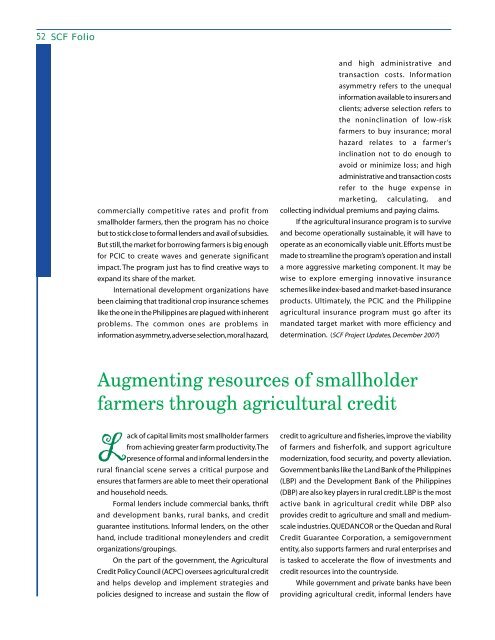Read More - Philippine Institute for Development Studies
Read More - Philippine Institute for Development Studies
Read More - Philippine Institute for Development Studies
Create successful ePaper yourself
Turn your PDF publications into a flip-book with our unique Google optimized e-Paper software.
52 SCF Folio<br />
commercially competitive rates and profit from<br />
smallholder farmers, then the program has no choice<br />
but to stick close to <strong>for</strong>mal lenders and avail of subsidies.<br />
But still, the market <strong>for</strong> borrowing farmers is big enough<br />
<strong>for</strong> PCIC to create waves and generate significant<br />
impact. The program just has to find creative ways to<br />
expand its share of the market.<br />
International development organizations have<br />
been claiming that traditional crop insurance schemes<br />
like the one in the <strong>Philippine</strong>s are plagued with inherent<br />
problems. The common ones are problems in<br />
in<strong>for</strong>mation asymmetry, adverse selection, moral hazard,<br />
and high administrative and<br />
transaction costs. In<strong>for</strong>mation<br />
asymmetry refers to the unequal<br />
in<strong>for</strong>mation available to insurers and<br />
clients; adverse selection refers to<br />
the noninclination of low-risk<br />
farmers to buy insurance; moral<br />
hazard relates to a farmer’s<br />
inclination not to do enough to<br />
avoid or minimize loss; and high<br />
administrative and transaction costs<br />
refer to the huge expense in<br />
marketing, calculating, and<br />
collecting individual premiums and paying claims.<br />
If the agricultural insurance program is to survive<br />
and become operationally sustainable, it will have to<br />
operate as an economically viable unit. Ef<strong>for</strong>ts must be<br />
made to streamline the program’s operation and install<br />
a more aggressive marketing component. It may be<br />
wise to explore emerging innovative insurance<br />
schemes like index-based and market-based insurance<br />
products. Ultimately, the PCIC and the <strong>Philippine</strong><br />
agricultural insurance program must go after its<br />
mandated target market with more efficiency and<br />
determination. (SCF Project Updates, December 2007)<br />
Augmenting resources of smallholder<br />
farmers through agricultural credit<br />
Lack of capital limits most smallholder farmers<br />
from achieving greater farm productivity. The<br />
presence of <strong>for</strong>mal and in<strong>for</strong>mal lenders in the<br />
rural financial scene serves a critical purpose and<br />
ensures that farmers are able to meet their operational<br />
and household needs.<br />
Formal lenders include commercial banks, thrift<br />
and development banks, rural banks, and credit<br />
guarantee institutions. In<strong>for</strong>mal lenders, on the other<br />
hand, include traditional moneylenders and credit<br />
organizations/groupings.<br />
On the part of the government, the Agricultural<br />
Credit Policy Council (ACPC) oversees agricultural credit<br />
and helps develop and implement strategies and<br />
policies designed to increase and sustain the flow of<br />
credit to agriculture and fisheries, improve the viability<br />
of farmers and fisherfolk, and support agriculture<br />
modernization, food security, and poverty alleviation.<br />
Government banks like the Land Bank of the <strong>Philippine</strong>s<br />
(LBP) and the <strong>Development</strong> Bank of the <strong>Philippine</strong>s<br />
(DBP) are also key players in rural credit. LBP is the most<br />
active bank in agricultural credit while DBP also<br />
provides credit to agriculture and small and mediumscale<br />
industries. QUEDANCOR or the Quedan and Rural<br />
Credit Guarantee Corporation, a semigovernment<br />
entity, also supports farmers and rural enterprises and<br />
is tasked to accelerate the flow of investments and<br />
credit resources into the countryside.<br />
While government and private banks have been<br />
providing agricultural credit, in<strong>for</strong>mal lenders have










